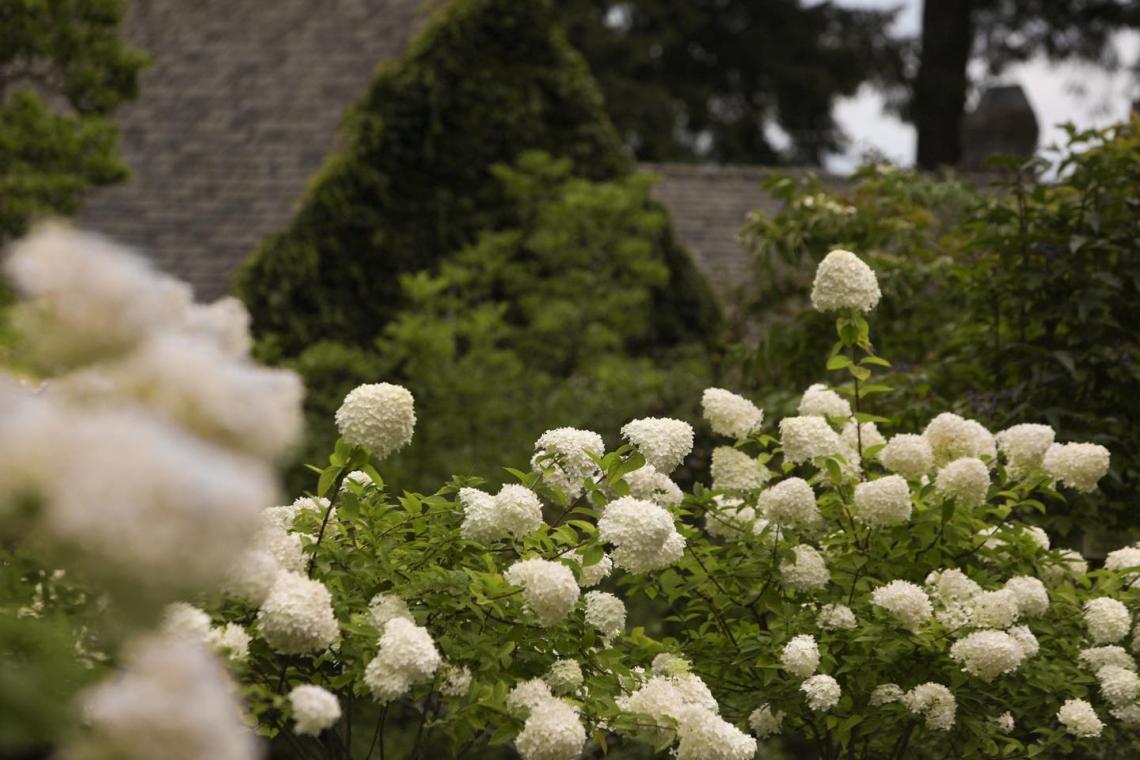Latin name: H. paniculata 'Limelight'
by Vancouver Island Master Gardeners Association
A popular hydrangea is H. paniculata ‘Limelight’, the center of attention and proven winner! Panicle hydrangea flowers are large, cone-shaped, up to 12 inches in length, and bloom on sturdy stems, sometimes to 10 feet tall. Flower color varies from creamy white to pale green, transitioning to pink hues as they mature later in the summer. Panicle hydrangeas bloom on new wood, meaning the flower buds form on stems growing this season. Thus, you should prune all the previous season’s stems to two or three pairs of buds in the spring, which will bloom in the coming summer, giving you a low structure. You can also do selective pruning and cut some older stems way back while leaving some a little longer. If you don’t prune it all, the flowers will be so high up that you will not be able to enjoy them after a few years. Panicle hydrangeas are best pruned in early spring to promote new flowering wood.

|
Attribute |
Description |
|---|---|
|
Form: |
‘Limelight’ is a multi-stemmed deciduous shrub with a dense bushy habit. Plants can be also trained into a tree form. |
|
Foliage: |
Dark green oval leaves have a pointed tip and slightly serrated edge. |
|
Height/Width: |
Original 'Limelight': 6 to 10 feet tall and wide |
|
Hardiness Zone: |
Limelight’ hydrangea is exceptionally hardy, down to USDA Zone 3 and up to Zone 9 making it a good choice for colder climates. |
|
Exposure: |
Full sun to partial shade. Choose a sheltered site that gets at least 4 to 6 hours of direct sunlight throughout most of the growing season. Protect from hot afternoon sun in hotter climates. |
|
Flower colour: |
Flower color varies from creamy white to pale green, transitioning to pink hues as they mature later in the summer. Red and burgundy flower colors persist in the fall. |
|
Leaf Colour: |
Dark green |
|
Flower Time: |
Limelight hydrangeas bloom in July or August and continue until later in the fall depending on the temperatures, adding color and interest to the winter garden. |
|
Preferred Soil & Watering: |
Provide evenly moist conditions. Don’t allow soil to dry out, which may result in brown flowers. Water more frequently during heat and dry spells. Avoid overwatering to prevent root rot. Limelight’ hydrangea is tolerant of different soils, though does best with well-drained soil and a slightly acidic to slightly alkaline pH. Unlike bigleaf hydrangea (Hydrangea macrophylla), soil pH does not affect flower color with Limelight hydrangeas. Good drainage is essential to prevent root rot. Plants are shallow rooted and will benefit from mulching to retain moisture and keep roots cool. Apply several inches of compost, shredded bark or bark chips around the base of plants each spring. For containers, use a high quality all-purpose potting mix. |
|
Pests & Diseases |
When grown in the right conditions, ‘Limelight’ hydrangea is free of most pests and diseases. Pests can include aphids, mites, scale, slugs and snails. Diseases include bacterial wilt, bud blight, leaf spot, powdery mildew, and rust. |
|
Other: |
Plants need little or no supplemental fertilizer. For more vigorous growth, apply a slow-release granular fertilizer in spring that’s specially formulated for trees and shrubs. Compost or bark mulch will also provide nutrients. |

